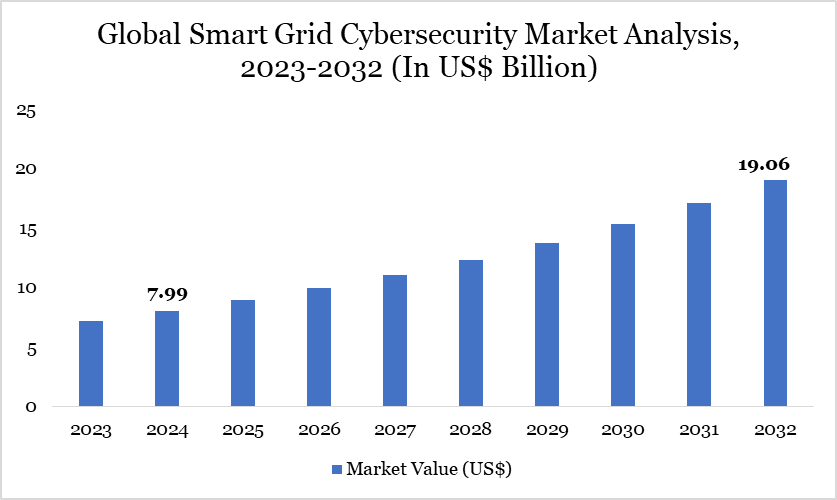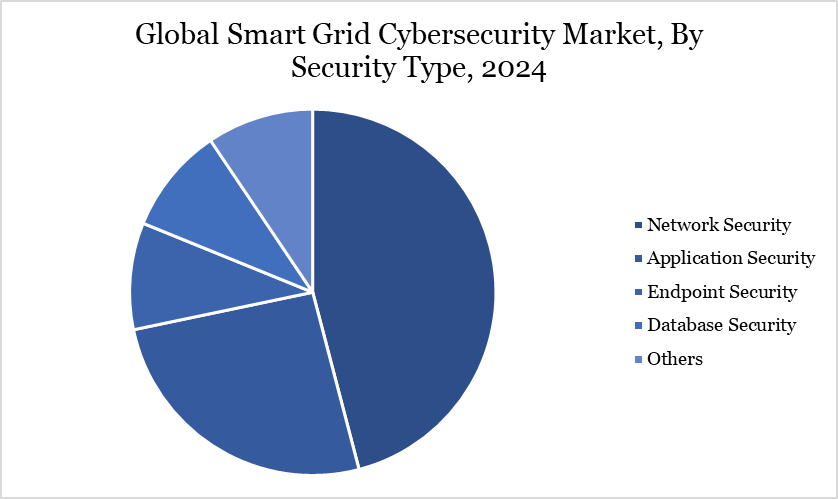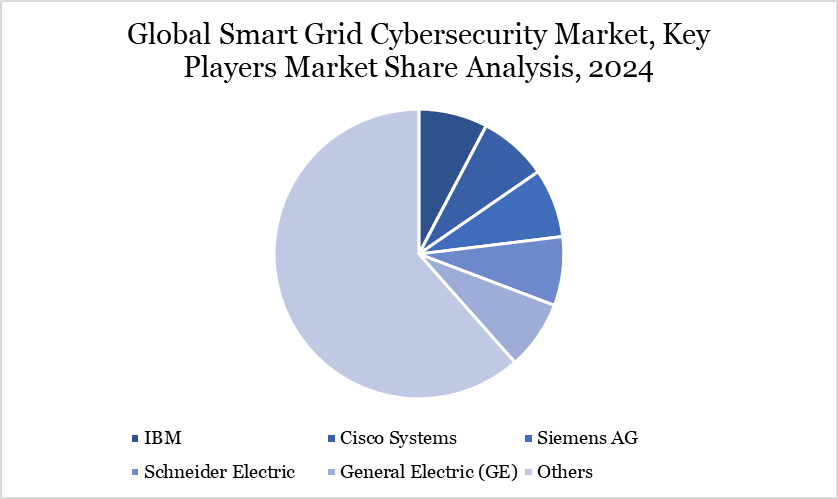Market Size
Global Smart Grid Cybersecurity Market size reached US$ 7.99 billion in 2024 and is expected to reach US$ 19.06 billion by 2032, growing with a CAGR of 11.48% during the forecast period 2025-2032.
The growing popularity of smart grids is attributed to favorable regulations implemented by governments globally and their efforts to promote energy conservation among the people. Moreover, the incorporation of these integrated components into the system, along with a heightened focus on reducing power blackouts, positions smart grid engineering to transform the traditional grid into a more reliable and resilient system.
Cybersecurity has emerged as a vital concern for electric utilities due to the digitization of the grid and the rising incidence of assaults on critical national assets. Electric utilities face an increasing risk landscape due to the rapid proliferation of connection points from Distributed Energy Resources (DERs), Electric Vehicles (EVs), mobile workforces, and cloud technology.
The market expansion can be ascribed to causes including improved grid dependability and heightened awareness regarding carbon footprint control. North America is anticipated to expand over the projected period, owing to the increasing emphasis on a strong regulatory framework for the implementation of renewable energy.
Smart grid cybersecurity Market Trends
Smart cities are advanced urban regions engineered to promote sustainable economic development and improve quality of life by excelling in critical areas such as technology, mobility, environment, living standards, and governance. Over 100 smart city programs are currently in progress globally, presenting substantial prospects for technology enterprises, utility service providers, and consultancy companies.
These towns utilize sophisticated resource management and innovative technologies, such as the Internet of Things (IoT) and smart energy meters to enhance key services in utilities, transportation, safety, and healthcare. Conventional power grids lack the efficiency and agility necessary to fulfill real-time energy monitoring requirements in these contexts.
A reliable smart grid infrastructure is essential for the centralized management and control of services in smart cities. Areas with advanced ICT infrastructure and extensive internet accessibility are more inclined to implement smart grid technologies. Rapid urbanization in the Asia-Pacific region is driving both developed and emerging countries to adopt smart city technologies, bolstered by infrastructure investments in nations such as China, India, and Brazil.

For more details on this report, Request for Sample
Market Scope
| Metrics | Details | |
| By Security Type | Network Security, Application Security, Endpoint Security, Database Security, Others | |
| By Deployment Mode | On-premises, Cloud-based, Hybrid | |
| By Component | Solution and Services | |
| By Application | Energy Generation, Energy Transmission, Energy Distribution, Energy Consumption, Others | |
| By End-user | Residential, Commercial, Industrial, Utilities, Others | |
| By Region | North America, South America, Europe, Asia-Pacific and Middle East and Africa | |
| Report Insights Covered | Competitive Landscape Analysis, Company Profile Analysis, Market Size, Share, Growth |
Global Smart grid cybersecurity Market Dynamics
Government Initiatives Driving Smart Grid Modernization
Governments globally have implemented several strategic initiatives and regulatory measures to encourage the deployment of smart grid technologies and enhance awareness of energy conservation. These initiatives are crucial for expediting the implementation of smart grid solutions in industrial, commercial, and residential sectors.
The US Department of Energy (DOE) received US$ 4.5 billion from the American Recovery and Reinvestment Act of 2009 (Recovery Act) to upgrade the national electric power infrastructure. The Smart Grid Investment Grant (SGIG) program enabled a joint investment of US$ 8 billion by the DOE and the power sector. This grant facilitated 99 cost-shared projects, engaging over 200 utilities and other organizations. The initiatives aimed at updating the electric grid, augmenting cybersecurity, expanding system interoperability, and gathering an unparalleled amount of data on smart grid performance and its related advantages.
Digital Transformation and Cybersecurity
On December 21, 2024, GE Vernova, a division of General Electric, launched the GridOS software platform to facilitate the upgrading and real-time administration of electric power grids. This platform facilitates the seamless integration of distributed energy resources, improves grid visibility, and fortifies cybersecurity standards.
Utility companies have escalating cybersecurity challenges with the rising complexity of power networks due to the incorporation of renewable energy, electric vehicles, and smart meters. As a result, companies are investing in sophisticated security technology integrated into grid management solutions.
The emergence of complete platforms underscores the industry's transition to digitization and accentuates the essential role of cybersecurity in protecting infrastructure. These advancements substantially enhance the increasing need for resilient cybersecurity solutions specifically designed for smart grid systems.
Interoperability and Standards Gaps Hamper the Growth of the Market
Despite the increasing implementation of smart grid technology, numerous significant constraints impede the effective deployment of cybersecurity measures. A primary difficulty is the insufficient awareness among smart grid system designers about existing standards, resulting in non-compliance during appliance manufacturing. The incorporation of outsourced and standardized components from many worldwide suppliers hinders device interoperability, hence restricting seamless communication inside utility networks.
Numerous manufacturers and equipment suppliers lack appropriate certifications, hindering utility companies' access to data from legacy systems. This problem is exacerbated by a lack of comprehension of IT communication protocols and the unavailability of essential components and devices required for implementation.
Although initiatives such as the Smart Grid Interoperability Panel (SGIP) by NIST and the issuance of energy standards in nations like China, Japan, Brazil, and India represent commendable advancements, the absence of universally accepted interoperability standards persists in limiting the comprehensive potential of the smart grid cybersecurity market.
Market Segment Analysis
The global smart grid cybersecurity market is segmented based on security type, deployment mode, component, application, end-user and region.

Network security segment is driving smart grid cybersecurity market
The network security type segment has emerged as significant force in the global smart grid cybersecurity market, accounting for approximately over 30% of the total market share in 2024. The increasing convergence of Information Technology (IT) and Operational Technology (OT) is driving the integration of production and enterprise networks. Simultaneously, the demand for remote access to OT environments is rising, necessitating enhanced protection measures.
To safeguard automation networks from unauthorized access, network security plays a critical role by monitoring all interfaces between corporate and plant-level systems, as well as remote maintenance entry points. This is achieved through advanced mechanisms such as network access control, segmentation, encrypted communication, and the adoption of Zero Trust security principles.
In the context of smart grids, which comprise a highly interconnected network of devices, systems, and communication protocols, network security becomes even more essential. The distributed nature of modern power infrastructure, spanning substations, control centers, smart meters, and distributed energy resources, makes secure data transmission a top priority. Network security ensures the integrity, confidentiality, and availability of data across these channels, effectively protecting against a wide range of cyber threats.
Market Geographical Share
North America’s Leadership in Smart Grid Cybersecurity Market Growth Driven by Clean Energy Integration
North America is the most rapidly growing region in the global smart grid cybersecurity market, propelled by many factors. A primary factor in this increase is the region's swift development of renewable energy systems, especially solar and wind energy. Governments throughout the region, particularly in the US, are providing incentives including tax credits and policy support to encourage the adoption of sustainable energy. Simultaneously, increasing environmental consciousness among stakeholders is propelling the transition to sustainable energy techniques.
The US is in the forefront of implementing smart grid solutions that enable the smooth integration of renewable energy sources into the current electricity infrastructure. Technological developments are important in this transformation, augmenting the grid's capacities regarding energy distribution, effective data collecting, and real-time monitoring and control. As the smart grid ecosystem advances, the necessity for comprehensive cybersecurity measures intensifies, consequently propelling expansion in the smart grid cybersecurity market throughout the area.
Sustainability Analysis
The integration of digital and electric technologies in smart grids is crucial for promoting sustainability through the reduction of carbon emissions and the improvement of energy efficiency. The adoption of distributed energy resources (DERs), electric vehicles (EVs), and cloud-based systems by utilities enhances the dependability and resilience of energy infrastructure. This digital transition concurrently heightens cybersecurity threats. The increase in cyberattacks, which doubled from 2020 to 2022 as reported by the IEA, poses substantial operational and financial hazards to critical infrastructure.
Utility organizations must establish comprehensive cybersecurity frameworks that adhere to global standards like ISA/IEC 62443 and NIST to guarantee environmental advancement and system security. A comprehensive defense-in-depth strategy, integrated with governance, risk management, and incident response capabilities, is needed.
Although the initial expenditure on cybersecurity may be substantial, the enduring advantages encompass operational continuity, diminished emissions, and protected digital infrastructure. As electrification progresses, ensuring the security of smart grids is essential for a robust and sustainable energy future.
Major Global Players
The major global players in the market include IBM Corporation, Cisco Systems, Siemens AG, Schneider Electric, General Electric (GE), Honeywell International Inc., Lockheed Martin Corporation, AlertEnterprise, AlienVault Inc., and Thales Group.

Key Developments
- In December 2024, Honeywell International Inc. introduced INNCOM Direct, an automated energy management system designed for mid-market hotels. The system improves energy efficiency by optimizing HVAC operation in unoccupied rooms. This corresponds with Honeywell's emphasis on automation and the energy shift. With as much as 30% of US hotel rooms perhaps unoccupied in 2024, INNCOM Direct aids in minimizing energy waste.
- In April 2024, GE Vernova's Grid Solutions division and Sonelgaz, Algeria's national electricity and gas enterprise, are augmenting the capacity of GE Algeria Turbines (GEAT) to implement advanced grid solutions. This strategic accord, achieved through the modification of their joint venture, emphasizes a dedication to furthering Algeria's energy objectives. It denotes a shared commitment to sustainable energy advancement, enhancement of local industrial capabilities, and promotion of economic success through technological innovation and collaboration.
Why Choose DataM?
- Data-Driven Insights: Dive into detailed analyses with granular insights such as pricing, market shares and value chain evaluations, enriched by interviews with industry leaders and disruptors.
- Post-Purchase Support and Expert Analyst Consultations: As a valued client, gain direct access to our expert analysts for personalized advice and strategic guidance, tailored to your specific needs and challenges.
- White Papers and Case Studies: Benefit quarterly from our in-depth studies related to your purchased titles, tailored to refine your operational and marketing strategies for maximum impact.
- Annual Updates on Purchased Reports: As an existing customer, enjoy the privilege of annual updates to your reports, ensuring you stay abreast of the latest market insights and technological advancements. Terms and conditions apply.
- Specialized Focus on Emerging Markets: DataM differentiates itself by delivering in-depth, specialized insights specifically for emerging markets, rather than offering generalized geographic overviews. This approach equips our clients with a nuanced understanding and actionable intelligence that are essential for navigating and succeeding in high-growth regions.
- Value of DataM Reports: Our reports offer specialized insights tailored to the latest trends and specific business inquiries. This personalized approach provides a deeper, strategic perspective, ensuring you receive the precise information necessary to make informed decisions. These insights complement and go beyond what is typically available in generic databases.
Target Audience 2024
- Manufacturers/ Buyers
- Industry Investors/Investment Bankers
- Research Professionals
- Emerging Companies

